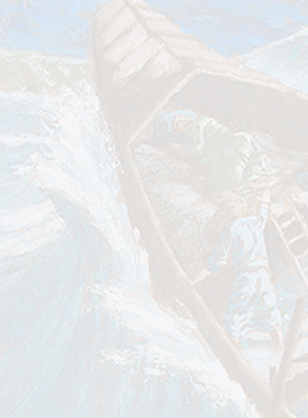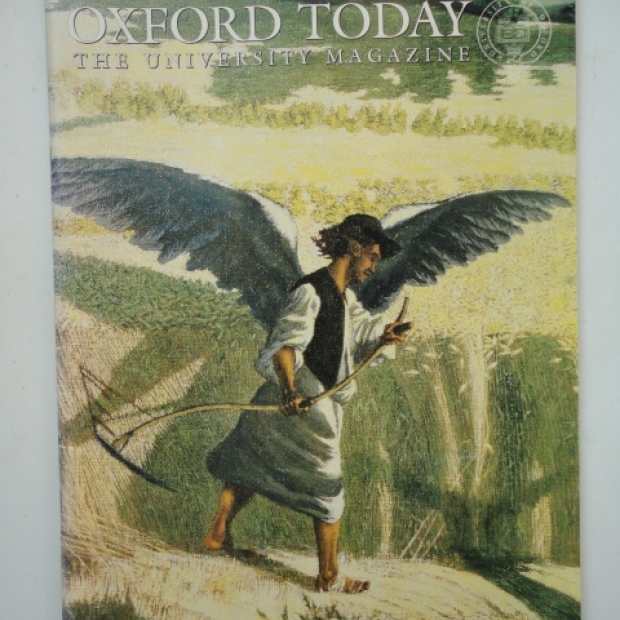Work > Articles
Seeing and Believing by Chris Miller
and Believing
Roger Wagner's Ashmolean exhibition reveals a poet-painter inspired by Christianity and the English landscape
ROGER WAGNER'S paintings are the product of an intense faith. By transposing key moments in the Christian narrative to his own times - a traditional practice - he invests his paintings with a startling metaphorical power. His current exhibition at the Ashmolean Museum testifies to his capacity to bring a sort of 'politics of transcendence' to contemporary scenes. Perhaps the most significant example of this is 'Menorah', a monumental crucifixion whose
'The Burning Fiery Furnace' (1989)
'The Black Poplar' (1991)
background is the cooling towers of Didcot pow station, near Oxford. The mourners at the crucifixion are dressed in the robes of Orthodox Jewry; they are dwarfed by Didcot's six cooling towers and central chimney. In Wagner's metaphor these form the Menorah, the seven- branched candlestick of the Jewish temple which symbolises the presence of God. Wagner's desolate scene, backed by billowing cloud and smoke from the power station, makes a symbolic unity of Holocaust and Crucifixion. It is a painting of radical intent, composed into an unforgettable portrayal of grief.
Wagner's Christianity - like that of Samuel Palmer, who set his painting 'The Rest on the Flight into Egypt' in the steep valleys of Kent - is closely identified with certain landscapes. One of these is the Suffolk countryside, near Aldeburgh. Another is Oxford. 'The Burning Fiery Furnace' (1989, ink, gouache and gum on blue paper) and 'The Black Poplar' (1991, also mixed media) are both set in Oxford, where Wagner studied and lives. In his final year (he took a First in English at Lincoln College in 1978), he lived in Mount Place, close to the canal. The house was almost in the shadow of Lucy's ironworks, where 'The Fiery Furnace' is set, and some ten minutes away from Port Meadow, where 'The Black Poplar' grows on the banks of the Thames. On one side of Lucy's ironworks is the Oxford-Birmingham canal, on another is St Sepulchre's graveyard. At night, the still water of the canal reflects the glare of molten iron. Having toured the ironworks, Wagner created his image by 'opening' the side of one of the crucible- like blast furnaces. It is a striking image of the power of the spirit in an alienating world of gantries and industrial waste.
'The Black Poplar' is associated with Wagner's Fire Sonnets, a sequence of sixteen sonnets, accompanied by wood engravings, which he hand- printed in 1984. Blake saw
'The Harvest' (1989)
'Angels planted in Hawthorn bowers'. For Wagner, the poplar rustles 'like a thousand angels' wings' (Sonnet IV). The image is part of Wagner's lyrical celebration of the created world; he might say, with Traherne, 'I will by the Light of my Soul show you the Univers'. The combination of blue paper and the heightening effect of the gum (another echo of Palmer) with the depth of the repeated coats of glaze
'Walking on Water' (1992)
gives a spectral quality to the image. It is a quality also found in Wagner's haunting representations of London's docklands.
Of the images illustrated here, the largest and most powerful is 'The Harvest' (1989, oil on canvas). The second of two paintings on this theme, it is impressive in scale (60x74in). Against the background of a Suffolk estuary, under bright sunlight not yet shadowed by thunderclouds, gaunt angels scythe and sheave like peasants. Wagner's vision is explained in his Fire Sonnets:
I saw the cherubim one summer's night Reaping it seemed an endless field of wheat. I heard their voices through the fading light Wild, strange and yet intolerably sweet.
In the painting, the angels are more sober, as well they might be. For the reference here is to Christ's parable of the tares: 'the harvest is the end of the world; and the reapers are the angels. As therefore the tares are gathered and burned in the fire; so shall it be in the end of this world'. Wagner's pastoral is a Last Judgment, its ternbilitas only enhanced by the blithe assurance of its presentation. For Wagner, the Last Judgment is a consummation greatly to be desired, leading to that happier state where 'the righteous shine forth as the sun in the kingdom of their Father'. It is difficult to see how faith can quarrel with this conclusion.
Roger Wagner's painting draws on the visionary tradition of Palmer and Blake to confront the contemporary world in no uncertain fashion. Born in 1957, Wagner spent 1978-81 as a guest student of Peter Greenham at the Royal Academy. The exhibition at the Ashmolean is his fourth one-man exhibition, and confirms a growing presence in English figurative art.
Chris Miller (Merton 1973)

